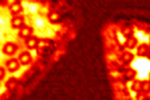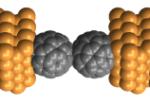RESEARCH

SPINTRONICS BELOW ONE NANOMETER
The demand for higher storage densities has boosted the analysis and characterization of nanoscale magnetic objects, as well as the writing and reading processes into these objects. Progress in this domain relies on improving our knowledge of magnetism and spin transport in reduced dimensions. The systems we study include molecules adsorbed on magnetic surfaces, which we access through SP-STM. Local information on the spin-filtering effect of molecules is gathered in this way, which can be complemented by investigating their magnetism by X-ray magnetic dichroism (XMCD) on a synchrotron beamline. Another approach consists in detecting the spin-flip of an electron colliding with an atom or a molecule coupled to non-magnetic electrodes through the Kondo effect (elastic scattering) or magnetic inelastic electron tunneling. The zero-bias conductance associated with spin-flip scattering is in fact a powerful spin-sensitive spectroscopic probe.

NANOSCALE OPTOELECTRONICS
Plasmonic light emission can be routinely observed in our STM tunnel junction. Light emission offers the unique possiblity of probing the shot noise in single-atom contacts, allowing to unveil fundamental physical aspects linked to the statistics of electrons passing through the contact. Light emission was recently extended to probe the optical response of molecular junctions. Fluorescence, phosphorescence, and thermal emission are some of the aspects that are currently being examined.

MOLECULAR ELECTRONICS
The ultimate spatial resolution of the STM coupled to its ability to manipulate matter at the atomic-scale offers the unique opportunity of engineering stable and reproducible two-terminal devices with knowledge of number, location and status of the molecule. Electron transport across single molecules and atoms can then be probed in a very controlled environment. Chemical and structural details of the electrode-molecule interface can be investigated without any limitations regarding the choice of the molecule or the electrode’s material. An original approach we developed in this context consists in attaching a target molecule to the apex of the STM tip. The molecular tip can then be used to measure electron transport through two interacting molecules having various chemical or physical properties.


